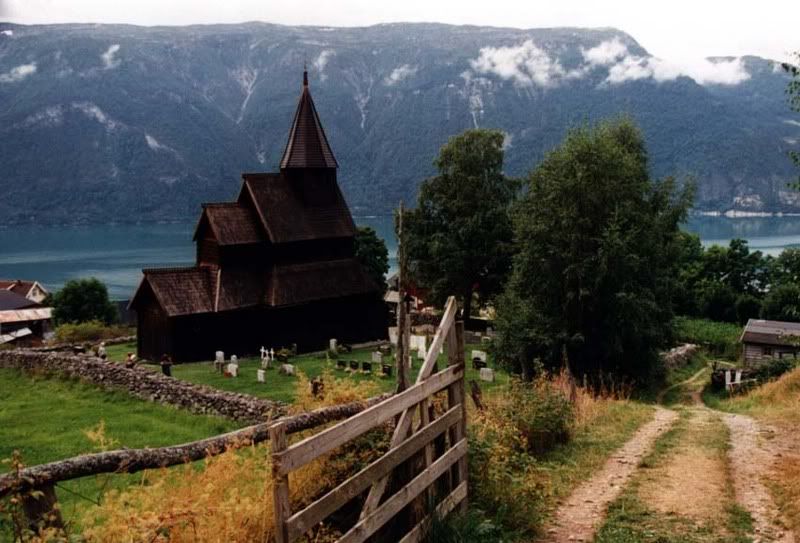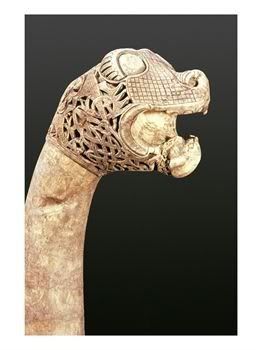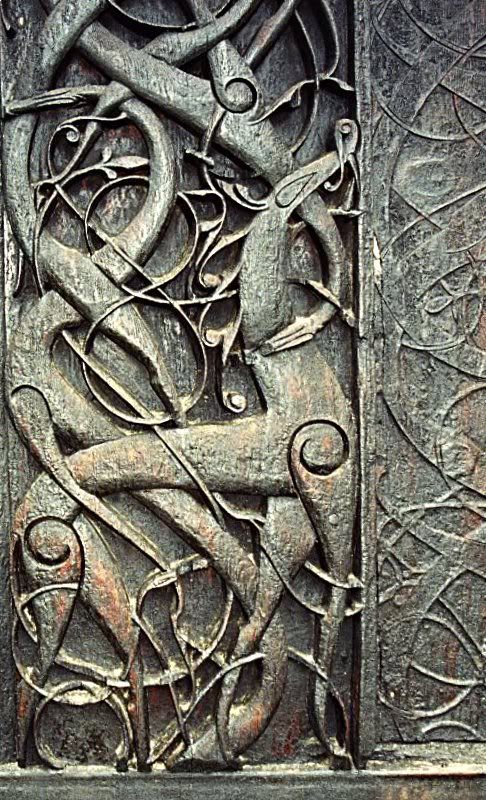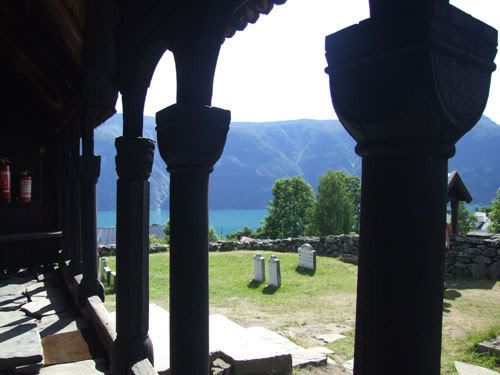Art: A Portal with Dragons
Well, it’s now official. I will be taking media studies this autumn, and in the spring I’ll hand in my master thesis in media studies. The fact that I already have a master in Art History points to the fact that I’m possibly a bit insane. (I’ve been through this shitstorm once - and now I’m doing it again? But I get to write about war films and Band of Brothers)
At any rate - both to keep me grounded and to hold on to whatever sanity I have left - I thought I’d post a bit about my favourite art objects.
(and if you are reading this Nol then know this is all you fault! The art posting I mean. Not the crazyness of doing media studies. Your question about my favourite art period got me thinking, and thinking, and thinking. Still no answer - but there is this:)
-----------------------------

Detail of Urnes Portal
The Portal of Urnes Stave Church
Portals and thresholds are dangerous places in all older, North European churches. They mark the division between the sacred inside and the profane outside -and thereby obtain a symbolic as well as practical function. The result is that most portals are lavishly decorated, often with saints and angels like the portals at Chartres or Vézelay.

The complete Portal of Urnes Stave Church
This is true for the Nordic Stave churches as well, but here the decorations differ slightly. Instead of angels there are monsters - not saints but meandering dragons. Transforming the focus of the portal to be not on the holiness inside the church, but on the dark terror of the world outside.

Urnes Stave Church with a view of the fjord. The church was built around 1130 AD, but the carvings on the portal are from an even older church
Stave churches are wooden buildings from predominately the 11th and 12th Century. They are called stav or pillar because they are built around a pillar supported structure. There are clear indications that these churches are based on earlier, pre-Christian and Viking building techniques. If this is true for the buildings then it is doubly so for the woodcarved
portals.

The Carved Dragon Head from the Oseberg Ship burial
Similar woodcarvings have been found in pagan ship burials, and it seems the old woodcarving techniques have simply been put to new use in regards to the churches.
To summarise: the portals, of which Urnes is one of the oldest, is the result of an old pre-Christian tradition adapted to a new Christian building and given the task of adorning and guarding a place of great symbolic and practical significance: the threshold.

Another detail shot of the portal
What I love about the Urnes portal is the swanky lines and the sheer depth of the carving. You see that dragon-horse like creature at the bottom and all the circles above it? That is one single piece of wood! Granted that means it’s a big tree, but imagine carving all those details and those flowing lines from one piece of wood. You cannot make mistakes. The smallest wrong cut, and you have to begin an new.
I also love how the curves of the cutting seem to swirl around the portal, giving it an almost organic feel. At times the portal appears more like it’s grown than been carved. It’s slightly uncanny. There is as a wild, chaotic feel to all the circles and fantastic creatures and I always feel it looks more like the gate to some dark mystery, than the door to a church. Perhaps to the people who carved it was a portal to something mysterious. I doubt their view of a church was the same as mine. Whatever it looks may entail the carving leaves no doubt about the portals important position. The lavish decorations signal quite clearly that this is the border to somewhere important.

A view from the portal and over the grave yard
At any rate - both to keep me grounded and to hold on to whatever sanity I have left - I thought I’d post a bit about my favourite art objects.
(and if you are reading this Nol then know this is all you fault! The art posting I mean. Not the crazyness of doing media studies. Your question about my favourite art period got me thinking, and thinking, and thinking. Still no answer - but there is this:)
-----------------------------

Detail of Urnes Portal
The Portal of Urnes Stave Church
Portals and thresholds are dangerous places in all older, North European churches. They mark the division between the sacred inside and the profane outside -and thereby obtain a symbolic as well as practical function. The result is that most portals are lavishly decorated, often with saints and angels like the portals at Chartres or Vézelay.

The complete Portal of Urnes Stave Church
This is true for the Nordic Stave churches as well, but here the decorations differ slightly. Instead of angels there are monsters - not saints but meandering dragons. Transforming the focus of the portal to be not on the holiness inside the church, but on the dark terror of the world outside.

Urnes Stave Church with a view of the fjord. The church was built around 1130 AD, but the carvings on the portal are from an even older church
Stave churches are wooden buildings from predominately the 11th and 12th Century. They are called stav or pillar because they are built around a pillar supported structure. There are clear indications that these churches are based on earlier, pre-Christian and Viking building techniques. If this is true for the buildings then it is doubly so for the woodcarved
portals.

The Carved Dragon Head from the Oseberg Ship burial
Similar woodcarvings have been found in pagan ship burials, and it seems the old woodcarving techniques have simply been put to new use in regards to the churches.
To summarise: the portals, of which Urnes is one of the oldest, is the result of an old pre-Christian tradition adapted to a new Christian building and given the task of adorning and guarding a place of great symbolic and practical significance: the threshold.

Another detail shot of the portal
What I love about the Urnes portal is the swanky lines and the sheer depth of the carving. You see that dragon-horse like creature at the bottom and all the circles above it? That is one single piece of wood! Granted that means it’s a big tree, but imagine carving all those details and those flowing lines from one piece of wood. You cannot make mistakes. The smallest wrong cut, and you have to begin an new.
I also love how the curves of the cutting seem to swirl around the portal, giving it an almost organic feel. At times the portal appears more like it’s grown than been carved. It’s slightly uncanny. There is as a wild, chaotic feel to all the circles and fantastic creatures and I always feel it looks more like the gate to some dark mystery, than the door to a church. Perhaps to the people who carved it was a portal to something mysterious. I doubt their view of a church was the same as mine. Whatever it looks may entail the carving leaves no doubt about the portals important position. The lavish decorations signal quite clearly that this is the border to somewhere important.

A view from the portal and over the grave yard